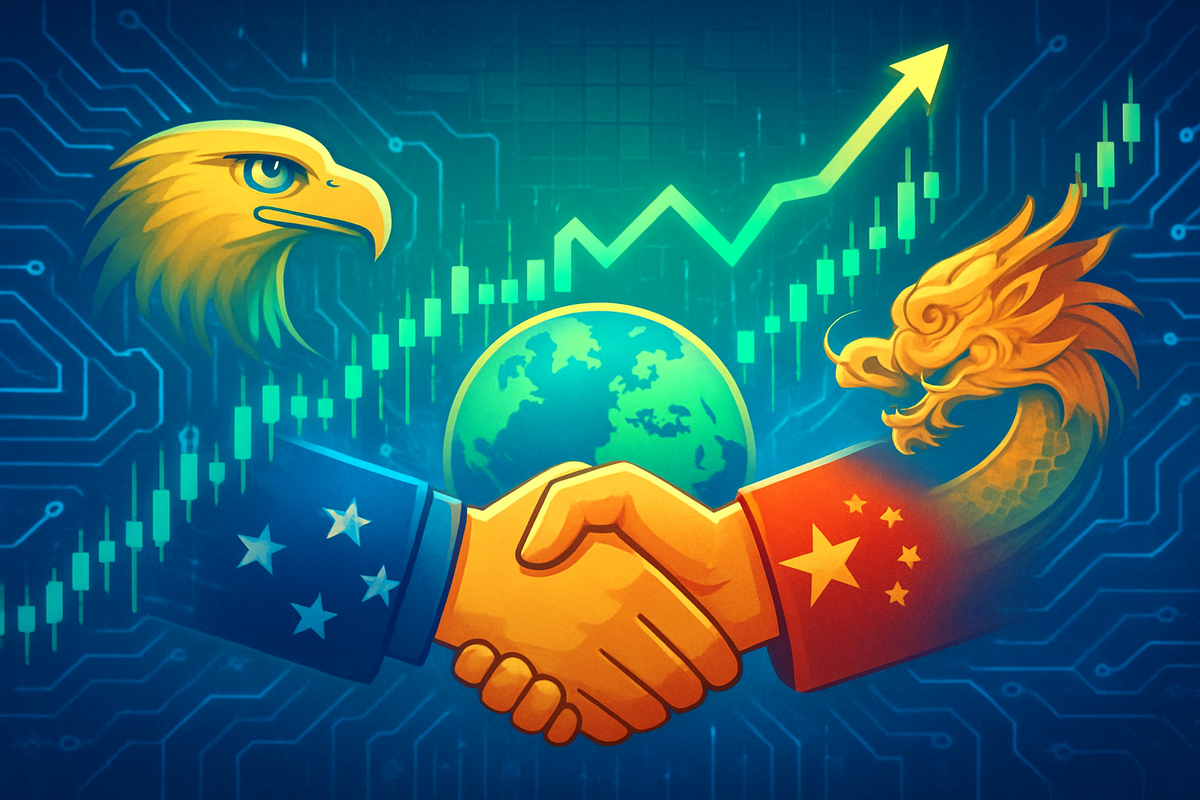Financial News
Tech Soars as China Trade Tensions Ease, Fueling S&P 500 Rally

New York, NY – October 17, 2025 – The technology sector delivered a robust performance today, leading broader market gains in the S&P 500 as investors reacted positively to significant developments indicating an easing of trade tensions between the United States and China. This optimistic shift, which had been anticipated by many market watchers, provided a substantial tailwind for tech giants and innovative startups alike, underscoring the sector's profound sensitivity to global geopolitical and economic stability. The day's trading saw a surge in confidence, with technology stocks closing markedly higher, reflecting renewed optimism for stable supply chains, enhanced market access, and reduced operational costs for companies heavily invested in the world's two largest economies.
The positive momentum in the tech sector was a primary driver behind the overall market's upward trajectory, contributing significantly to the S&P 500's strong finish. This performance highlights the critical role the technology industry plays in the global economic landscape, where even subtle shifts in international relations can trigger substantial market movements. As the specter of prolonged trade disputes recedes, the sector is poised to capitalize on a more predictable operating environment, potentially unlocking new avenues for growth and innovation that had been constrained by previous uncertainties.
A Diplomatic Breakthrough Ignites Market Optimism
Today's market rally was ignited by a series of diplomatic overtures and announcements between Washington and Beijing, signaling a tangible de-escalation of long-standing trade tensions. While specific details of the agreements are still emerging, initial reports suggest a commitment to phased tariff reductions and a renewed dialogue on intellectual property rights and market access. This hypothetical breakthrough comes after months of quiet negotiations, with both governments reportedly keen to foster a more stable global economic environment.
The timeline leading up to this moment has been characterized by intermittent periods of heightened rhetoric and cautious optimism. Following years of tit-for-tat tariffs and restrictions, particularly impacting the semiconductor and telecommunications industries, a concerted effort to find common ground appears to have gained traction in recent weeks. Key players involved in these discussions included high-level trade representatives from both the U.S. and Chinese administrations, alongside influential industry lobbyists who have consistently advocated for a more open and predictable trade landscape. Initial market reactions were immediate and overwhelmingly positive, with tech-heavy indices showing significant gains within minutes of the news breaking, indicating widespread relief among investors.
Tech Giants Poised for Gains, Supply Chains Breathe Easier
The easing of China trade tensions is set to create a significant cohort of winners within the technology sector, primarily benefiting companies with substantial manufacturing operations, sales, or supply chain exposure in China. Among the most prominent beneficiaries are likely to be consumer electronics behemoths like Apple (NASDAQ: AAPL), which relies heavily on Chinese manufacturing for its flagship products, and semiconductor giants such as Qualcomm (NASDAQ: QCOM) and Intel (NASDAQ: INTC), whose global sales and supply chains are deeply intertwined with the Chinese market. These companies stand to gain from reduced input costs due to lower tariffs, improved efficiency in their complex supply chains, and enhanced market access.
Beyond the hardware sector, software and internet services companies with a significant presence in China, including some U.S.-listed Chinese tech firms like Alibaba Group Holding Limited (NYSE: BABA) and JD.com, Inc. (NASDAQ: JD), are also expected to see a boost. The de-escalation reduces the regulatory and operational uncertainties that have plagued cross-border business. While the overall sentiment is overwhelmingly positive, potential "losers" are less apparent in this scenario. However, companies that had heavily invested in diversifying their supply chains away from China purely due to trade war fears might find their strategic advantage slightly diminished as the impetus for such drastic shifts lessens. Nonetheless, the benefits of a more stable trade environment are expected to far outweigh any minor re-calibrations.
Broader Implications for Industry and Global Commerce
This easing of trade tensions fits squarely into a broader industry trend seeking greater global integration and supply chain resilience, rather than outright decoupling. For years, the tech sector has grappled with the dual pressures of globalization's efficiencies and the vulnerabilities exposed by geopolitical friction. This development suggests a renewed emphasis on finding pragmatic solutions that allow for continued cross-border collaboration while still addressing national security and economic concerns. The potential ripple effects are vast, extending to partners across Asia and other emerging markets that are integral to the global tech supply chain.
Regulatory and policy implications could include a renewed focus on multilateral trade agreements and a potential re-evaluation of export control policies that have impacted specific technologies and companies. Historically, periods of trade de-escalation have often led to surges in foreign direct investment and increased cross-border mergers and acquisitions in the tech space. Comparisons can be drawn to previous periods of improved U.S.-China relations, which consistently correlated with significant growth for multinational tech firms that successfully navigated both markets. This event could signal a return to a more predictable and mutually beneficial economic relationship, fostering an environment where technological innovation can thrive without undue geopolitical interference.
Navigating the Path Ahead: Opportunities and Challenges
In the short term, the market is likely to experience continued bullish sentiment, particularly within the technology sector, as investors digest the full implications of easing trade tensions. This could translate into sustained stock rallies and increased capital expenditure by tech companies looking to capitalize on reduced costs and expanded market opportunities. Long-term possibilities include a potential resurgence of joint ventures and technology transfers between U.S. and Chinese firms, fostering greater collaboration on cutting-edge research and development in areas like artificial intelligence, quantum computing, and sustainable technologies.
However, companies will still need to exercise strategic foresight. While the immediate pressure to implement "China Plus One" diversification strategies might lessen, the underlying principle of supply chain resilience remains paramount. Market opportunities could emerge in areas previously constrained by trade barriers, such as specialized components or services. Challenges might still persist in navigating evolving regulatory landscapes and ensuring compliance with intellectual property protections. Potential scenarios range from a gradual, sustained improvement in trade relations to intermittent periods of renewed tension, underscoring the need for adaptable business models and robust risk management strategies.
A New Chapter for Tech and Global Trade
Today's positive movement in the S&P 500 Technology sector, propelled by easing China trade tensions, marks a significant turning point for the industry and global commerce. The key takeaway is a renewed sense of stability and predictability, which is critical for a sector characterized by long investment cycles and complex global operations. This de-escalation suggests a path forward where economic interdependence can be managed through dialogue rather than confrontation, benefiting consumers and businesses worldwide.
Moving forward, investors should closely watch for the specifics of any trade agreements, their implementation, and any further signals from both governments regarding their commitment to maintaining stable relations. The resilience of global supply chains, the pace of tariff reductions, and the impact on corporate earnings will be crucial metrics to monitor in the coming months. While the path ahead may still present challenges, today's developments offer a compelling vision of a more interconnected and prosperous future for the technology sector and the global economy it serves.
This content is intended for informational purposes only and is not financial advice
More News
View More




Recent Quotes
View More
Quotes delayed at least 20 minutes.
By accessing this page, you agree to the Privacy Policy and Terms Of Service.



